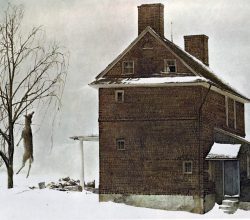
EASEL ESSAY: Andrew Wyeth, his Critics, and Small Town Mud
Morgan Meis | 15th November 2016
Andrew Wyeth might just be America’s most popular painter. People feel at ease with his work. It seems straightforward, depicting rural and small town scenes that figure large in America’s yearnings about itself. But contemporary critics were not enthused and little has changed since.
Well, the critics should look more closely, argues Contributing Editor Morgan Meis. Wyeth’s favourite subject was indeed small town America. But he wasn’t trying for nostalgia or homey. Rather, he was seeking to tap into the particular psychology of that world, the mood of a small town that is so different to city life.
“There is one other crucial element to Wyeth’s [Tenant Farmer]: the dead deer hanging from the rope of a solitary tree. The deer hangs ominously, by the neck, like it has been executed for a crime. … On the one hand, there is the house—that massive pile of reddish bricks crying out for all the materiality that tempera can deliver. The bricks want to be given their due, each brick … But the bricks of Tenant Farmer are merely an inert mass without the hanging deer. The deer brings that disturbing incongruence into the picture, that element of risk. It’s as if the hung deer and the brick house need one another. Together, they become complementary components of the undeniable reality that Wyeth wants to show us.”
